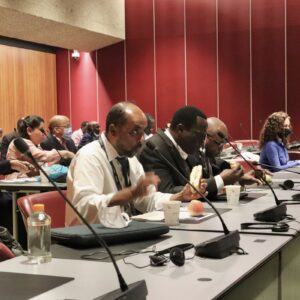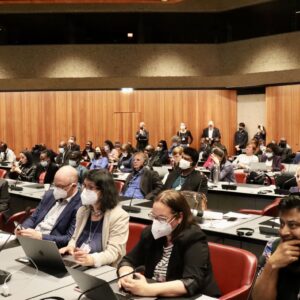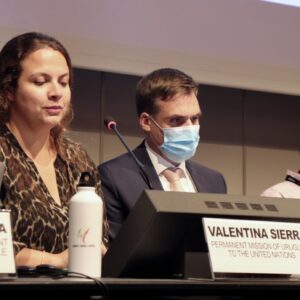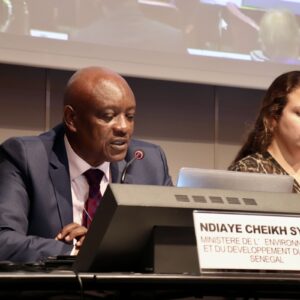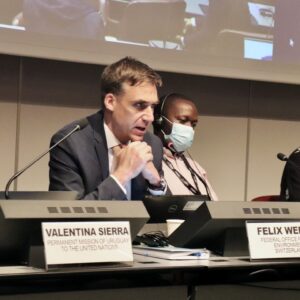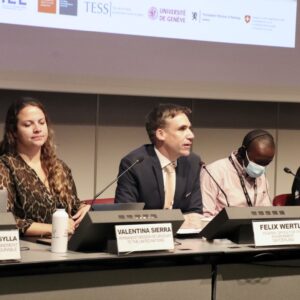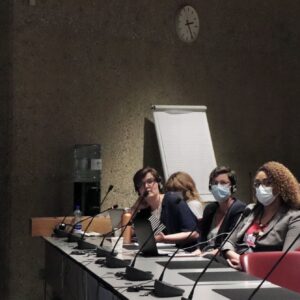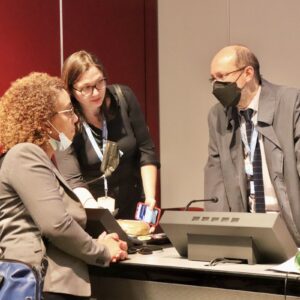Event Conference
Health, Chemicals, Plastics & a Non-Toxic Circular Economy | Geneva Beat Plastic Pollution Dialogues & BRS COPs Side Event

09 Jun 2022
13:15–14:45
Organization: International Pollutants Elimination Network, Switzerland, Uruguay, Geneva Environment Network
This side event to the 2022 meetings of the Conference of the Parties to the Basel, Rotterdam and Stockholm Conventions (BRS) discussed how a new global agreement on plastic pollution could address the toxic impacts of chemical additives on human health and develop a safe circular economy. This event is organized by the International Pollutants Elimination Network (IPEN), the governments of Switzerland and Uruguay, and the Geneva Environment Network, within the framework of the Geneva Beat Plastic Pollution Dialogues.

About this Event
In March 2022, the 5th United Nations Environmental Assembly (UNEA5) made a historic decision to begin negotiations for a binding agreement to end plastic pollution. The International Negotiation Committee (INC) will have a broad mandate to address plastic pollution in all its aspects and impacting all environments. The UNEA plastic treaty mandate includes key references and starting points related to toxic chemicals and health including addressing the life-cycle, design and a safe circular economy.
All plastic materials are made of chemicals, many of which are known hazardous chemicals, that threaten public health, the environment and whose continued use would threaten the goal of a safe circular economy. While some of these known chemicals are regulated in some countries, most of the hazardous chemicals can be exported in products without controls. Allowing the continued use of hazardous chemicals as plastic ingredients without controls on their toxic impacts on human health and on the environment could lead to unsafe stockpiles of plastics for recycling and an unsafe circular economy.
This session provided an overview of the key issues the INCs will address, related to how ubiquitous chemicals in plastics, particularly endocrine disrupting chemicals (EDCs), can impact human health, and the circular economy challenges regarding hazardous chemicals. Experts shared their perspectives on a non-toxic circular economy, and opportunities for a plastics treaty to address the health hazards of plastics and of their hazardous chemical ingredients throughout their life-cycle.
The event is included in the programme of the Plastics Forum, taking place from 8 to 10 June 2022, as part of the 2022 meeting of the Parties to the Basel, Rotterdam and Stockholm Conventions.
The Geneva Beat Plastic Pollution Dialogues
![]()
The world is facing a plastic crisis, the status quo is not an option. Plastic pollution is a serious issue of global concern which requires an urgent and international response involving all relevant actors at different levels. Many initiatives, projects and governance responses and options have been developed to tackle this major environmental problem, but we are still unable to cope with the amount of plastic we generate. In addition, there is a lack of coordination which can better lead to a more effective and efficient response.
Various actors in Geneva are engaged in rethinking the way we manufacture, use, trade and manage plastics. The Geneva Beat Plastic Pollution Dialogues aim at outreaching and creating synergies among these actors, highlighting efforts made by intergovernmental organizations, governments, businesses, the scientific community, civil society and individuals in the hope of informing and creating synergies and coordinated actions. The dialogues highlight what the different stakeholders in Geneva and beyond have achieved at all levels, present the latest research and governance options.
Following the landmark resolution adopted at UNEA-5 to end plastic pollution and building on the outcomes of the first two series, the third series of dialogues will encourage increased engagement of the Geneva community with future negotiations on the matter. These include the meetings of the Intergovernmental Negotiating Committee (INC) from the second half of 2022 to 2024, as well as preparatory meetings within the ad-hoc open-ended working group during the first half of 2022. The series will also continue to foster stronger cooperation and coordinated actions ahead of other milestones in the environmental agenda, including the BRS COPs, SAICM ICCM5, the 2022 UN Ocean Conference, UNEA-6 and other processes in Geneva, such as at the WTO.
Speakers

Laura N. VANDENBERG
Endocrine Society, Associate Professor at University of Massachusetts Amherst’s School of Public Health and Health Sciences

Griffins OCHIENG
IPEN Plastic Working Group Co-Chair, Kenya
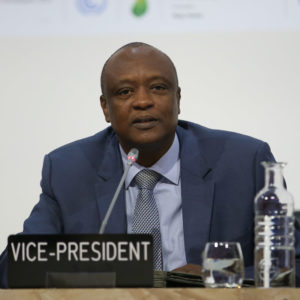
Cheikh Ndiaye SYLLA
Director, Ministerial Cabinet for Environment and Sustainable Development, Senegal
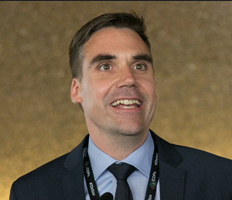
Felix WERTLI
Head, Global Affairs Section, Federal Office for the Environment, Switzerland
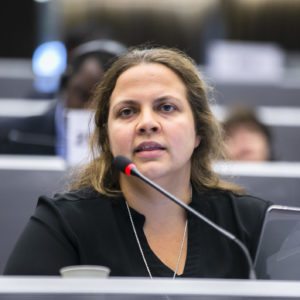
Valentina SIERRA
Permanent Mission of Uruguay to the United Nations in Geneva

Marcos ORELLANA
UN Special Rapporteur on Toxics and Human Rights

Richard BROWN
Chemical Safety and Health Unit, Department of Environment, Climate Change and Health, World Health Organization

Tadesse AMERA
Co-Chair, IPEN | Moderator

Pamela K. MILLER
Co-Chair, IPEN | Moderator
Video
Highlights
Laura Vandenberg of @UMassAmherst highlights how endocrine disrupting chemicals — exogenous substances that interfere with hormone action — have altered certain human diseases overtime, including changes in ages where menarche occurs or decreases in sperm count.#PlasticsForum pic.twitter.com/ROwpM5EP6z
— GENeva Environment Network (@GENetwork) June 9, 2022
Summary
Welcoming Remarks | Pamela K. MILLER, IPEN Co-Chair
The BRS COPs are an important venue regarding plastics, with the Stockholm Convention addressing certain POPs in plastics and the release of dioxins in the plastics life cycle, and the Basel Convention aiming to apply control to plastic waste. Plastics and POPs are global problems. Endocrine-disrupting chemicals (EDCs), which can be found in plastics, are hazardous to human health.
IPEN welcomes the decision taken at UNEA in March 2022 to begin negotiations towards a plastics treaty. This demonstrates an increased attention to the harm that plastics cause to human health and the environment, including the use of chemicals throughout the life cycle. The plastics treaty could become a new global health instrument that prevents the disproportionate effects that plastics have on human health and the environment, the vulnerable populations, and in low- and middle-income countries. As a global network of over 600 public interest and public health organizations in 127 countries, IPEN is please to be active in the plastics treaty process with the aim to make this new treaty meaningful.
Health, Chemicals and Plastic Materials | Laura N. VANDENBERG, Endocrine Society, Associate Professor at University of Massachusetts Amherst’s School of Public Health and Health Sciences
EDCs are exogenous chemicals or chemical mixtures that interfere in some way with hormone action. Most EDCs that have been identified to date can either mimic or block the actions of hormones, such as sex or thyroid hormones. In December 2022, the Endocrine Society and IPEN published a guide, summing up the state of scientific knowledge on EDCs and plastics. These results come from years of research and hundreads of peer-reviewed studies.
Over the last several decades, changes in several conditions or diseases in human populations have been observed, all of which can be linked back to hormones or hormonal action. Over the past century, the average age of reaching menarche and average sperm count are both decreasing. Meanwhile, endocrine disorders – such as endocrine-mediated cancers, ADHD and diabetes – are becoming more prevalent over the couple last decades. These changes are happening over periods of time where genetics could not possibly be changing; therefore pointing to the role of environmental causes such as EDCs. Data and references on these trends can be found in the presentation (available for download below).
Various EDCs can be found in plastics, and these are linked to reproductive disorders, cancer, diabetes, obesity and neurological impairments, thus posing serious threats to human health. A concern point is that EDCs poses high risk at key point in the life cycle, including during pregnancy, childhood and puberty thus threatening vulnerable population. Studies on animals further revealed that the effects of EDCs can be transmitted over several generations.
Many different kinds of EDCs found in plastics have been linked to negative health effects. A full overview can be found in the guide. Three classes are of particular relevance to today’s event:
- UV stabilizers are added to products to protect against damage from UV radiation, prevent product fading, inhibit corrosion and minimize fog. An example is UV-328, an environmentally persistent chemical which has been measured in bodies of wildlife and humans, and has anti-androgenic behavior.
- Brominated flame retardants is used to reduce flammability of plastic products. Its associated health effects include disruption of reproductive development, as well as alteration of thyroid development and neurodevelopment.
- Bisphenol A (BPA) is found in various products, including food containers and packaging, media equipment, water pipes and more. BPA is known to affect brain development and behavior, reproductive health and is associated with mammary, prostate, ovarian and endometrial cancers. Related chemicals which can be used as substitutes (BPS, BPF and others) have similar effects.
Plastics are all around us, which means EDCs are too. EDCs are released from plastics in the environment, contributing to contaminating of water, soil, air and food. We cannot ignore the connections between plastics, EDCs and health. More plastics will likely lead to increased exposure to EDCs, thus making these problem worse. There is no sustainable way of dealing with plastic waste, including its chemical additives. We must act to prevent further harm.
New Data from Africa, Asia and Latin America | Griffins OCHIENG, IPEN Plastic Working Group Co-Chair, Kenya
IPEN is a global network of public interest organization working toward a toxics-free future for all. IPEN has 25 years of experience in treaty negotiations, starting with the Stockholm Convention. Each stage of the plastics life cycle is associated with hazardous chemicals, from extraction to production, use, recycling, and disposal. IPEN has conducted various studies to assess the exposure to these hazardous chemicals.
- Production of plastics pellets: a study analyzing plastic waste found on beaches across all continents have found that 100% of samples contain PCBs and UV stabilizers. Half of the locations surveyed have high or extremely high PCB levels.
- Production of plastics products: plastic materials contains various EDCs. For example, 78% of baby bottles sampled contained BPA. Furthermore, 61% of samples labelled “BPA-free” actually did contain BPA. Another study found that 84% of clothing sampled contained PFAS.
- Recycled plastic materials: recycled pellets surveyed in Africa, Asia, Europe and Latin America all contained at least one substance among BPA, BFR and UV stabilizers. 84% of those contained all three substances. A further study found banned BFRs in all the surveyed samples. Data from African countries showed tan a majority of recycled material products have BFRs levels exceeding 50 ppm. This data was published in a peer reviewed journal with an article on the exposure of children to dioxin through recycled plastic toys.
- End-of-life toxic emissions and release: a study of eggs from areas where plastic is burned in incinerators revealed 92% of tems had dioxins levels above EU health standards. An article with this data showed that monitoring of dioxins and PCBs in eggs is a sensitive indicator for environmental pollution and contaminated sites.
In summary, plastics poison the circular economy. The data that IPEN has gathered shows that the linkages between plastics, chemicals and health are of great concern.
Video on the impacts of plastics, chemicals and health in Africa
Panel Discussion
How can the plastics treaty help control the use and exposure to hazardous chemicals in the life cycle of plastics?
Felix WERTLI | Head, Global Affairs Section, Federal Office for the Environment, Switzerland
Following the important decision taken at UNEA, we are engaged in an major process to address plastic pollution. Scientific inputs into this process are very important. We know that there are over 10’000 chemical substances used in plastic production. Moving forward, a few key elements are to be enhanced:
- More scientific information about the types of plastics. This would allow a better understand and assessment of which kind of plastics are found, which is appropriate for recycling and how do we have to treat it as waste.
- Adopt a life cycle approach. Currently only about 10% of plastic is recycled; we have to increase recycling. However, in order to have a safe, non-toxic circular economy, we need to have information available about the content of plastic products in order to deal with them properly. This is essential not only for recycling, but also for upcycling. In order to create new products out of plastic waste which are safe, we need to know what was in the material we recycle.
- Use improved information to design control measures through the new treaty. Restricting certain additives could create a basis for a safe circular economy. UV-328, currently under consideration for the Stockholm Convention, is a good example. The Basel Convention also shows what can be done to address plastic waste, and how some elements of the new treaty can be designed. This highlights how existing instruments can be used as inspiration for the new plastics treaty, for example by using annexes
- Create incentives. For instance, extended producer responsibility (EPR) can be a solution, as we know from experience that it is not easy to go substance by substance in a multilateral arena. We need to promote standards, labels and certification schemes, while ensuring their quality to avoid greenwashing. Here, we need to harness the knowledge of the private sector.
- Learn from examples at the national level. There are many examples of EPR schemes to promote circular economy or other regulations to limit specific substances. These may apply to different context and vary from developing to develop countries, from island to landlocked state, etc. Having a good overview of the different tools that we have at the moment at the national level can help us think further on the best tools to promote and those most appropriate to each context.
Valentina SIERRA | Permanent Mission of Uruguay to the United Nations in Geneva
At UNEA5.2, we agreed to start the negotiating process, with the goal to adopt a legally binding instrument on plastic pollution that addresses the full lifecycle of plastics and includes the marine the marine environment by the end of 2024. Some of the main elements that are included in this resolution are relevant to chemicals :
- Recognition of the problem of the negative impacts on the environmental, social and economic dimension of sustainable development. It is important to emphasize the dimension of plastic pollution prevention and its related risks to human health and wellbeing. The negative impacts on human health, on the environment and on human rights should be reflected more clearly in the future agreement.
- Life cycle approach to plastic pollution. The resolution recognized that plastic pollution needs to be tackled throughout a lifecycle approach but we still need to have a common understanding of what we mean by this. Chemicals that are used during production, consumption and waste management should be also discussed this process and considered in the treaty. Cross cutting issues should be addressed jointly to improve their core benefits
- Multi-stakeholder engagement. A multi stakeholder forum will take place in the first INC and hopefully during the whole process. This will be a great opportunity to learn more. All stakeholders are encouraged to participate. Participation of the private sector is important to have a deep understanding on how the sector works, how the life cycle is like, where the producers and the consumers are located, etc. Uruguay encourages the participation of the participation of NGOs without restrictions, as well as of the BRS and SAICM secretariat, the academia and scientists, the health and labor sectors, workers and informal workers, and youth representatives.
What guiding principles should be adopted to achieve a non-toxic circular economy for plastics?
Valentina SIERRA | Permanent Mission of Uruguay to the United Nations in Geneva
Guiding principles regarding a non-toxic circular economy need to be highlighted. The UNEA resolution makes reference to sustainable production and consumption of plastics, sound management of waste, and circular economy. These are fundamental and need to be included in the treaty. The resolution also includes social aspects, recognizing the significant contribution made by workers under informal and cooperative setting and the health impacts on waste picked. Uruguay also promotes this approach under ILO.
Chemicals in plastics also make plastic less recyclable; so this needs to be addressed as well. We need to eliminate as much as possile the toxic chemicals in plastic production in order to have a non-toxic circular economy. Finally, the resolution highlights sustainable alternatives and technologies, as well as enhanced international collaboration to facilitate access to technology capacity building and scientific and technical cooperation.
Cheikh Ndiaye SYLLA | Director, Ministerial Cabinet for Environment and Sustainable Development, Senegal
A non-toxic circular economy can only be achieved if there are no toxic chemicals added to plastic or if the toxics added will no affect in any way health human or the environment throughout the life cycle of plastics. For many African countries, this is very difficult to achieve due to the early reuse of the plastics by the informal sector. For instance, early reused plastics are often used for food packaging, and most do not meet the criteria for food contact. There is a high risk of additives entering food, causing all kind of illness including cancer through ingestion. This is why all plastic must be designed for recycling, so that no plastic is burned, dumped or landfilled, knowing that we cannot recycled plastics indefinitely.
Although the new agreement should address this issue at country level, taking into consideration region-specific regulation, the framework of the new agreement should include the definition of global standards. Recycling of plastics containing toxic chemicals, including POPs, are threatening lives in Africa, Middle East, and elsewhere in the world. Senegal stands ready to develop the new agreement on plastic pollution taking into account its local context. With regards to technology transfer, we must take care of the dumping of unclear equipment, and think how to improve plastics recycling and disposal. Protecting health and the environment should guide us in the INC negotiations.
What are existing laws and gaps in international law in relation to recycling plastics with hazardous chemicals (Stockholm Convention), and trading of plastic waste (Basel Convention)?
Marcos ORELLANA | UN Special Rapporteur on Toxics and Human Rights
The mandate on toxics and human rights was created to deal with the transfer of hazardous wastes from the global North to the global South. The Human Rights Council eventually in time reframed the mandate to deal with chemicals and wastes in a life cycle fashion. The first mandate holder already dentified sham recycling as a pathway of the transfer of hazardous wastes to the global South. The problem we are facing is not new.
The report presented by SR Toxics to the UNGA last year analyzes the international legal landscape of instruments that concern the plastics problem, revealing a high fragmentation either because of regional scope or spatial scope or subject matter. Action under the regional seas conventions, the International Maritime Organization, the Stockholm Convention or the Basel Convention, are all limited in that regard. As the problem does not life with just one element in the life cycle of plastics, we need an instrument that can reach all stages. A new global instrument that addressed comprehensively the plastic threat is essential.
There is also a concern specific to the Basel convention about loopholes that are enabling the transfer of plastics to the South under the concept of repairable products or substances. Streams of waste shipped under this loophole will have impacts, as they contain hazardous substances like other plastics and are likely to be burned.
Existing instruments provide useful models to build on and think of what is expected from the new agreement. As we know, restricting additives is essential to achieve a non-toxic circular economy. On that point, perhaps National Action Plans are not the most effective. We could be thinking instead of annexes that include those chemicals which may be used (rather than those forbidden like under the Stockholm Convention). This could enable a truly non-toxic circular economy.
What are the opportunities for a plastics treaty to protect human health and the environment?
Richard BROWN | Chemical Safety and Health Unit, Department of Environment, Climate Change and Health, World Health Organization
Looking at the future instruments, the first area for future improvement is research and the mechanisms for disseminating information. There is currently a lot of uncertainty in this area. In 2019, the WHO published a report on microplastics in drinking water. The results highlighted the uncertainty around the effects of microplastics in drinking water and the need for more research in order to resolve those uncertainties. This can be extended to other areas regarding the effects of plastics on human health.
The WHO is following up with an additional report on microplastics in other media, such as air, food and soil contamination, and the effects via ingestion and inhalation. While the report is not available yet (expected to be published in the second half of 2022), we already know it is unlikely to conduct an quantitative assessment because of these continuous uncertainties and lack of information.
A new global instrument could help stimulate the necessary research to help resolve those uncertainties and identify what are the most important concerns. Our first report was already a call for action to stop the rise of plastic pollution worldwide. We hope the new instrument can stimulate action in that direction.
Felix WERTLI | Head, Global Affairs Section, Federal Office for the Environment, Switzerland
We have to fully understand that health is part of the treaty, and it should be well mentioned if the objectives of the treaty. It is important that relevant organizations, like the WHO, provide information into the negotiating process. Within the UN system, we have to get out of the silos and support enhanced cooperation, in particular in the field of environment and health. The resolution adopted at UNEA on the science-policy panel on chemicals, waste and pollution will also help in that regard. Although the panel has yet to be established and will not be available during negotiations, it could inform the development of the treaty.
An effective treaty would reduce the use of plastics in order to contribute to human health. We need to ensure that the alternatives used are better to avoid duplicating or displacing the problem. The plastics treaty is an opportunity to place prevention as a key element, by reducing plastics production. The first question we need to ask ourselves is where we can easily replace plastics. There are plenty of absurd examples in daily life where we use plastics where it wouldn’t be needed. We have to think along the value chains, where can we replace plastics and what alternatives can be used.
Finally, we need to take chemical additives into account. When we talk about health, we have to consider the toxic chemicals in plastics and how to address them. We need to reduce the harmful additives that are harmful to human health and the environment.
Q&A
Q: How can EPR be linked to a plastic waste management circular economy in developing countries?
Felix WERTLI: More information on experiences must be gathered. EPR can be used as a means to incentivize or disincentivize the use of certain plastic materials and facilitate the trade of some materials over others.
Q: Why are health national plans not effective to tackle the global plastic crisis? What alternatives are there?
Marcos ORELLANA: In the absence of clear global objectives and clearly defined standards national action plans are not particularly effective.
Cheikh Ndiaye SYLLA: National action plans provide an overview of data and indicators specific to countries, but not all financial mechanisms require countries to report on results like the Montreal Protocol does. Regional approaches can and should complement NAPs.
Felix WERTLI: All that can be done to prevent the aggravation of the plastic crisis must be done to avoid the consequent fiscal aggravation of all the phenomena related to this crisis. Design and research to improve the sustainability of toxic products require financial support.
Valentina SIERRA: The possible establishment of a science-policy panel can support NAPs to address these issues more comprehensively and identify technologies and alternatives for the future.
Q: What are other transformation processes occurring to generate plastic besides incineration? How dangerous are these to health? Can the plastic production process be made cleaner?
Richard Brown: These can include dioxins whose health indications are being studied by WHO.
Q: How will a treaty on plastic pollution be enforced? Which mechanisms will be in place to ensure monitoring of implementation?
Felix WERTLI: Good examples from other treaties and conventions will set the example for the one on plastic pollution but so far these aspects have not been discussed in depth.
Q: How can the design of products that contribute to a non-toxic circularity be balanced with their durability and the possibility to be recycled? When plastic alternatives will be used to replace current plastic products, what will be the volume they will be able to cover? Will these still be classified as plastics?
Richard BROWN: It would be ideal if the health cost of producing something was incorporated within the whole cost of production.
Closing Remarks
Richard BROWN: The WHO has been looking at the issue of microplastics: a 2019 report on microplastics in drinking water has shown that there is still great uncertainty. Another report will be published soon looking at microplastics in other media, including in the food chain and the soil.
Felix WERTLI: We have a unique opportunity in international environmental governance [through the new plastics treaty]. In conventions such as BRS, we have good intentions in creating them, but at times, they do not work in the way we hoped. We need to be careful in designing and developing such conventions. It is also important the the new treaties and conventions do not replace existing ones. It will take a long time to establish and implement the new treaty, so we need to do what we can now to beat plastic pollution.
Valentina SIERRA: To have a successful treaty, we need multi-stakeholder agreements, broad participation and political will.
Cheikh Ndiaye SYLLA: The major group will engage and will help to effectively help the issue and leave nobody behind. I hope this treaty will allow this broad engagement.
Marcos ORELLANA: Given the grave toxification of the planet, we as humanity need to change our trajectory and move toward a non-toxic environment. This new instrument gives us the opportunity to do that. For the instrument to be effective and legitimate, adopting a rights-based approach will be key: just transition, putting vulnerable people, especially children first, enable access to information for people, provide them control over such toxic chemicals.
Griffins OCHIENG: As IPEN continues to elevate the issue of chemicals, it has been critical to bring this issue of health and toxic chemicals into the conversation and the INC process. This is a very good conversation as we move into such a conversation, and I thank partners for enabling this.
Pamela MILLER: As a community-based researcher in the Arctic on EDCs, plastic pollution has been seen in the remotest of places. The Arctic is a hemispheric sink of chemicals, POPs, and now plastics and chemicals found in them, which have contaminated traditional food of indigenous peoples living in the region. Climate warming is exacerbating the mobilization and transport of plastics within and into the Arctic. We have seen chemicals and plastic sequestered in sea ice, glaciers and permafrost, being released into important areas ecologically and culturally. This is not an abstract issue, but a public health issue that we must solve together with extreme urgency. We hope to come together and negotiate a treaty that is based on health and human rights.
Documents
Gallery
Links
The resource page on Plastics and the Environment provides further information on the impacts of plastic pollution on people and the planet, the current activities ongoing in Geneva and beyond to address the plastic crisis, with the latest scientific findings and news on the matter.
- IPEN’s Toxic Plastics Campaign
- Geneva Beat Plastic Pollution Dialogues
- IPEN Plastics Treaty Platform | Protecting human health and the environment from toxic chemicals | IPEN | May 2022
- 3 Key Principles for a Plastics Treaty – IPEN Quick Views for Dakar OEWG Meeting | IPEN | May 2022
- Hazardous Chemicals in Plastic Products | IPEN | May 2022
- Panelists Agree Chemicals Important to Future Plastic Treaty | IPEN | 15 March 2022
- Plastic Poisons the Circular Economy | IPEN | 13 February 2022
- New global studies show health threats throughout the plastics supply chain | IPEN | 13 December 2021
- Toxic Chemicals in Plastic Waste Poisoning People in Africa, Asia, Central and Eastern Europe & Latin America | IPEN | 22 June 2021
- Geneva Beat Plastic Pollution Dialogues – Plastics and Health | Geneva Environment Network | 21 January 2021
- 7 Harmful Chemical Types in Plastics | IPEN & The Endocrine Society | 2020
- Everyday Plastics Are Leaching Hazardous Chemicals | The Endocrine Society | 18 December 2020
- Plastics, EDCs & Health: Authoritative Guide | Endocrine Society and IPEN | 10 December 2020


